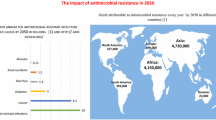Summary
The emergence of antibiotic resistance is primarily due to excessive and often unnecessary use of antibiotics in humans and animals. Risk factors for the spread of resistant bacteria in hospitals and the community can be summarised as overcrowding, lapses in hygiene or poor infection control practices. Increasing antibiotic resistance in bacteria has been exacerbated by the slow pace in developing newer antibiotics.
Methicillin-resistant Staphylococcus aureus (MRSA), vancomycin-resistant enterococci (VRE) and multiresistant Gram-negative bacteria are spread primarily by direct or indirect person-to-person contact. Independent risk factors for MRSA include the use of broad spectrum antibiotics, the presence of decubitus ulcers and prosthetic devices while those for VRE include prolonged hospitalisation and treatment with glycopeptides or broad spectrum antibiotics. For the spread of resistant Gram-negative bacteria risk factors include urinary catheterisation, excessive use of antibiotics and contamination of humidifiers and nebulisers.
The spread of penicillin-resistant pneumococci (PRP) and drug-resistant and multidrug-resistant tuberculosis (MDRTb) is due to airborne transmission. Risk factors for the spread of PRP include overcrowding, tracheostomies and excessive use of penicillins for viral respiratory infections; for MDRTb they include poor compliance, convergence of immunosuppressed patients, delayed diagnosis or treatment, and poor or inadequate ventilation and isolation facilities.
Recent developments in the genomic mapping of many bacteria and advances in combinatorial chemistry promise to usher in a new era of antibiotic development. While this may result in our regaining some of the ground lost to resistant bacteria, there will still be a continuing need to minimise the spread of antibiotic resistance through the rational use of antibiotic agents and stringent infection control practice.
Similar content being viewed by others
References
Abraham EP, Chain E, Fletcher CM, et al. Further observations on penicillin. Lancet 1941; II: 177–88
Dancer SJ. From tropics to tundra: experiences of a travelling microbiologist. PHLS Microbiol Dig 1997; 14(1): 11–7
Swann Report of the Joint Committee on the use of antibiotics in animal husbandry and veterinary medicine. London: HMSO, 1969
Consumption of antimicrobial agents and occurrence of antimicrobial resistance in bacteria from food animals, food and humans in Denmark. Danish Integrated Antimicrobial Resistance Monitoring and Research Programme (DANMAP) 1997 Feb (No. 1)
Haley WH. Incidence and nature of endemic and epidemic nos-ocomial infections. In: Bennett JV, Brachman PS, editors. Hospital infections. 2nd ed. Boston: Little Brown, 1986
Linton AH. Flow of resistance genes in the environment and from animals to man. J Antimicrob Chemother 1986; 18 Suppl. C: 189–97
Crawford LM, Shotts EB. Animal uses of antibiotics. In: Stuart-Harris CH, Harris D, editors. The control of antibiotic resistant bacteria. London: Academic Press, 1982
Nicolle LE, Strausburgh LB, Garibaldi RA. Infections and antibiotic resistance in nursing homes. Clin Microbiol Rev 1996 Jan; 9(1): 1–17
Spera RV, Farber BF. Multiple-resistant Enterococcus faecium: the nosocomial pathogen of the 1990s. JAMA 1992; 268: 2563–4
Bates J, Jordan JZ, Griffiths DT. Farm animals as a putative reservoir for vancomycin-resistant enterococcal infections in man. J Antimicrob Chemother 1994; 34: 507–14
Klare I, Heier H, Claus R, et al. Van A mediated high level glycopeptide resistance in Enterococcus faecium from animal husbandry. FEMS Microbiol Lett 1995; 125: 165–92
Woodford N, Johnson AP, Morrison D, et al. Current perspectives on glycopeptide resistance. Clin Microbiol Rev 1995; 8: 585–615
Gopal Rao G, Ojo F, Kolokithas D. Vancomycin-resistant Gram positive cocci: risk factors for faecal carriage. J Hosp Infect 1997; 35: 63–9
Livornese LL, Dias S, Samel C, et al. Hospital acquired infection with vancomycin resistant Enterococcus faecium transmitted by electronic thermometers. Ann Intern Med 1992; 117: 112–6
Murray BE, Singh EKV, Markowitz SM, et al. Evidence of clonal spread of single strain of β-lactamase-producing Enterococcus faecalis to six hospitals in five states. J Infect Dis 1991; 163: 780–5
Hansman D, Buller MM. A resistant pneumococcus. Lancet 1967; II: 264–5
Appelbaum P. Emerging resistance to antimicrobial agents in Gram-positive bacteria. Drugs 1996; 51 Suppl. 1: 1–45
Austrian R. Confronting drug resistant pneumococci. Ann Intern Med 1994; 121(10): 807–9
Cartmill TDI, Panigrahi H. Hospital outbreak of multi resistant Streptococcus pneumoniae. J Hosp Infect 1992; 20: 130–2
Gould FK, Magee JG, Ingham HR. A hospital outbreak of antibiotic resistant Streptococcus pneumoniae. J Infect 1987; 15: 77–9
O’Brien TF, International Survey of Antibiotic Resistance Group. Resistance to antibiotics at medical centres in different parts of the world. J Antimicrob Chemother 1986; 18 Suppl. C: 243–53
Isenan MD. Treatment of multidrug-resistant tuberculosis. N Engl J Med 1993; 329: 784–91
Wenger PN, Offer J, Breeder A, et al. Control of nosocomial transmission of multi-drug resistant Mycobacterium tuberculosis among healthcare workers and HIV infected patients. Lancet 1995; 345: 235–40
Centers for Disease Control. Nosocomial transmission of multi-drug resistant tuberculosis in health care workers and HIV infected patients in an urban hospital-Florida. MMWR Morb Mortal Wkly Rep 1990; 39: 718–22
Communicable Diseases Surveillance Centre. Outbreak of hospital acquired multidrug resistant tuberculosis. CDR 1995; 5: 34: 161
Beck-Sangne C, Dooley SW, Hutton MD, et al. Hospital outbreak of multi-drug resistant Mycobacterium tuberculosis infections: factors in transmission to staff and HIV infected patients. JAMA 1992; 268: 1280–6
Magtami P, Jolley DJ, Watson JM, et al. Socio-economic deprivation and notification rates for tuberculosis in London during 1987–91. BMJ 1995; 310: 963–6
Teale C, Cundell DB, Pearson SB. Outbreak of tuberculosis in a poor urban community. J Infect 1991; 23: 327–9
Knowles D. Genome based approaches to antibiotic discovery. 20th International Congress of Chemotherapy; 1997 1 July: Sydney
Orenstein WA, Hinman AR, Bart KJ, et al. Immunisation. In: Mandell GL, Bennett JE, Dolin R, editors. Principles and practice of infectious diseases. 4th ed. New York: Churchill Livingstone, 1995
Fuller R. Probiotics in human medicine. Gut 1991; 32: 439–42
Author information
Authors and Affiliations
Rights and permissions
About this article
Cite this article
Gopal Rao, G. Risk Factors for the Spread of Antibiotic-Resistant Bacteria. Drugs 55, 323–330 (1998). https://doi.org/10.2165/00003495-199855030-00001
Published:
Issue Date:
DOI: https://doi.org/10.2165/00003495-199855030-00001




